Well, it's time for the report from the last RGB championship race of the season.
We left Cambridge late and got up to Snetterton at about 9pm on the Friday evening before the race meeting on
the Saturday. I had wanted to test on the Friday but work intervened and made it impossible. As it turned out,
that may have been a good thing as it was apparently fairly wet on the test day with a drying line appearing only
at the end of the day. At least, unlike Donington, I do know this particular circuit pretty well and I can easily
check on gears and so on by poring over the old data logs. It would have been nice to think that I could manage
to go faster than I had done but it could well be that the weather would intervene and make that impossible.
Race morning dawned very bright and I was up early. I even managed to get the car scrutineered early which, after
the mess that we had here earlier in the year, was a relief. Then, while waiting for our quali session the skies
started to get darker and darker. It started to drizzle slightly and there was a huge black thunderstorm approaching
from the south. It was quite interesting looking at it and seeing all the lighting flashes inside it.
So, I rushed to cover the car up again and watched trepidatiously.
Then, it seems as though the storm saw us, decided it didn't like the look of us, and turned sharp right and went
off towards Norwich instead. After that the weather was great and we actually got home with a bit of sunburn. It
was really a fantastic weekend, with very much an end of term aspect to it.
Back on planet earth we traipsed over to the assembly area where we got noise tested. I managed a measly 99dbA
which is clearly not trying. I had noticed from inside the car that the new exhaust was much quieter than the old
one; I'm considering racing without earplugs again as it's hard to hear the engine properly. Problem is, without
'plugs there's all this banging and crashing over the kerbs.
Out on the circuit it was pretty uneventful. In retrospect I was too laid back really and didn't try hard enough.
I don't know why, perhaps it's just the end of season effect. In particular, there are two corners at Snetterton
that are of the "brake rather later than you thought" variety (Riches and the Esses) and I just didn't
work hard enough at getting my braking late enough. I kept arriving at the Esses, in particular, having slowed
down too much. This is, of course, why testing would have been a very good idea. Next year I might try and be a
bit more mechanistic about booking test days.
What was good, though, was the new gearbox was working a treat. There wasn't a single missed gear all day and
that's a great relief. Problem is, even though I didn't miss a gear, I was still too slow on the main straight.
I only got up to about 120mph whereas it was about 130 back in April. I really don't know why this is, although
later investigations have made it obvious that there's something awry with the charging system.
So, having not really being held up, apart from a lap messed up due to Gordon spinning in front of me, I only managed
a miserable 17th, which was 9th in class. The time was 1:21.6 which is about a second slower than I've managed
before. Gordon's spin was an interesting lesson. I passed him on the exit of Sear just as he was getting back onto
the circuit. That the power of his (class A) engine meant he passed me into the Esses makes you realise how much
more power those chaps have got.
So, back to the paddock and the car was checked over and refueled and we chilled out in the usual RGB manner: endless
discussions of the effects of the class structure. Come the race time and the weather was still fine and I got
the unusual honour of being first in the assembly area. Normally it's impossible to beat Tim Pell and Jonathan
Wright but I guess the end of term aspect had spread to these guys too, especially as the latter has already wrapped
up the championship.
Out onto the grid and we got away smartly, which was a relief after waiting on the line for an age at Donington.
What's more, I could see the lights here which was great. However, my start wasn't great and I bogged down and
lost about 3 or four places. One was to Simon who shot past me into Riches. There's something special about his
car, which is Dustin Barnes' old car, in that it seems much quicker than it should. Mind you, Simon reckons it's
right down on the weight limit which is bound to have an effect. I got past Simon into Sear, with my second best
manoeuvre of the year, but he slipstreamed past me on the Revett straight.
After that there was a bout of sorting out and in the process I got passed by Dick. He's a new chap who's racing
Jonathan's old MegaBusa having driven it for absolutely the first time during qualifying. He got past me due to,
again, an excess of power. However, I nearly got past him again between the two bits of the Esses and I was just
about to dive down the inside of him into the chicane when Colin C appeared on my left, surprised the living daylights
out of me, and slotted in front of me out of the chicane. I thought at that point that Colin and I were about to
have one of our race long battles again.
On the run away from the chicane I had the legs on him and went for the inside at Riches even though he made a
big try to shut the door. I didn't quite make it but as it was both Colin and I went past Dick at Riches. I think
we rather surprised him; having looked at the video he tried to tuck in behind Colin and probably didn't realise
I was there. Down to Sear and Colin ran really wide and I had a big oversteer moment. (Since I fitted the LSD this
car is huge fun on these sorts of occasions. Mind you, I seem to have returned to my one-handed opposite
lock tendencies which is a bit embarrassing to see on the video.)
Down the straight and I almost managed to slipstream past Colin and take him into the Esses. See above about braking
too early. I sat behind him all round Coram and got a better line out of the chicane which enabled me to just out
drag him on the pit straight. After that, for some reason, I just managed to drive away from him. He complained
after that I always managed to beat him at Snetterton. However, when looking at the lap chart I see that the 3
laps after I passed Colin were the fastest that I drove. In retrospect I suspect I went to sleep after that.
After that it was pretty much a non-event. I essentially drove around behind Neil. I kept catching up but as soon
as one or other straight arrived he used the additional power to get away from me. I did feel, too, that the engine
was down on power as the race proceeded. It was certainly, yet again, running too hot at about 100 degrees. The
ideal for a blade is about 85 so I need to put yet more thought into this. Currently I'd like to duct the radiator
out of the top of the bonnet, probably with the radiator tilted over somewhat.
Finally, I finished in 12th place which was 7th in class. As usual I've finished better at Snetterton than I do anywhere else. I'm sure this is due to it being the local circuit and the one I know the best. I really do have to get more testing time in at other circuits.
So, apart from the Birkett, that's it. Thanks to everyone's support during this season. I just need to decide now what to do to the car over the winter.
By the way, a final note. I'd like to thank all the people who mail me about these web pages. I really appreciate you all telling me they're useful. Quite a few people have admitted to aiming for competing in RGB over the next year or so. That's great as we need all the racers we can get! Just try not to bend it too soon.
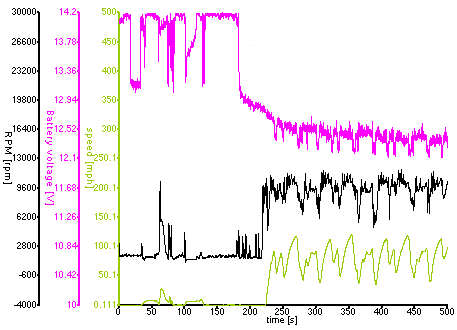 It does seem, though,
that the car was getting slower as the race was going on. I don't think this was entirely me. After looking at
the logs later I noticed something odd in that the battery voltage was much lower than it normally is.
It does seem, though,
that the car was getting slower as the race was going on. I don't think this was entirely me. After looking at
the logs later I noticed something odd in that the battery voltage was much lower than it normally is.
In fact, it seems to start out OK and then drop as the engine's revved. The graph here is of the first few laps of the Snetterton race. The bottom trace is speed: you can see the speed bumbling along as the car was driven out of the assembly area and then it gets going properly after the start. The middle trace is rpm and the top one is battery voltage. As you can see, the latter starts out at 14V or so, which is what you'd expect. Then, as the cars sitting on the grid it starts dropping and ends up down around 12V or so. This is far too low. The reason for being interested in this is that when the alternator's being loaded with a necessity to charge the battery it actually takes a small amount of the engine's power output.
Looking back at the logs, this has been the case since the accident at Silverstone, the same thing applied all the way through the meeting at Donington.
So, I need to find out what's going on. The first possibility is that the battery itself was damaged by the shunt. This is possible so I'll try replacing it. (Oddly, I've got a spare which is brand new; it doesn't even have the acid in it yet.) If that doesn't do anything I shall have to worry about the wiring and the voltage regulator.
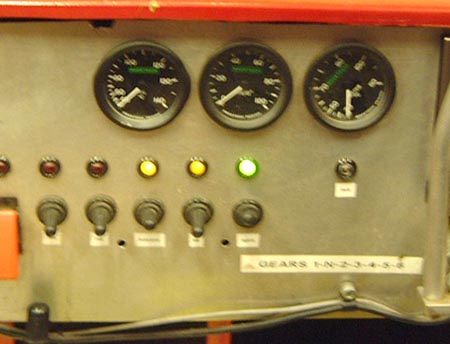 Later...
Later...
Well, I replaced the battery and, pretty much as expected it made no difference at all. This is a bit of a shame as it means I've now put the acid in my spare battery so from now on it starts degrading. Oh well.
Luckily the same effect on the battery voltage can be seen when running the car in the garage. Of course, I get asphyxiated and the neighbours complain but they're minor problems.
However, I also tried something else in turning on large electrical loads while the car was running. As you may remember I've got lots of LEDs for all the switched circuits in the car. (I get some stick for this but I'm a great believer in lights for debugging things.) Anyway, I turned on the headlights and immediately noticed that the LEDS for the dip switch and indicators became dimly. They definitely didn't use to do this and so there's clearly something wrong with the electrics.
In the photo on the left the rightmost switch is the light switch which is the only switch that's actually on.
I suspect that what's happened is that something's gone wrong with the earthing as a result of the crash. As the bodywork flailed around quite a lot and pushed the dash about it's possible that something unpleasant's happened to the wiring. I'll have to have a careful look as soon as I've got time. At least now I've got an easy diagnostic (those lights) so I don't have to keep gassing myself.
Time to get stuck into what I've got to do to the car pre-Birkett. First thing was to find out what was up to the electrics. I managed to find out why the leds above were glowing which was just down to grot in one of the lighting connectors, in this case the one that connects to the lights in the bonnet at the front right. These are out in the weather so I guess it's not surprising that they have this sort of trouble. All the same I might change the connectors over the winter though.
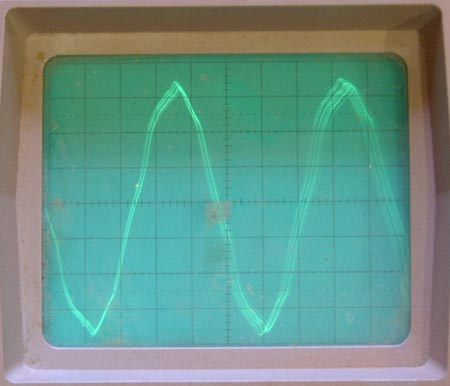 That
doesn't explain what's up the battery voltage then so I started digging a bit deeper. At one point I could when
the engine was running a considerable drop in battery voltage when I turned on the headlights. As the headlights
are rated at about 100W for the pair, and as the alternator's rated at 450W at 5000rpm (which I exceeded when testing,
the neighbours must love me) then there was clearly something fundamentally up with the charging system.
That
doesn't explain what's up the battery voltage then so I started digging a bit deeper. At one point I could when
the engine was running a considerable drop in battery voltage when I turned on the headlights. As the headlights
are rated at about 100W for the pair, and as the alternator's rated at 450W at 5000rpm (which I exceeded when testing,
the neighbours must love me) then there was clearly something fundamentally up with the charging system.
Eventually, I ended up looking at what was actually coming out of the alternator. which is what's in the photo here. The regulator's disconnected here so this the raw output straight from the stator coils. The alternator's a 3-phase device and this is just one of the three outputs. (It's not really just one phase as the output's wired in delta which makes life a little more complicated.) All the same this is a perfectly reasonable looking near sine wave. It's probably not a real sine wave due to the finite number of stator coils and magnets in the end of the crank.
On the subject of charging, there's a new thing in the regs for next year in that we're supposed to have an alternator charge warning light like they do on cars. As the on one cars works by a sort of trick in that it shows you the current needed to get the field (rotor) windings started then it's going to be harder with a bike engine as their alternators don't have field windings as they use permanent magnets in the end of the crankshaft. I'm going to have to fake something by measuring the battery voltage. There's a suggestion that we can do it with an AC relay but I'm not allowing a relay anywhere near my car, there's already enough contacts to fail as it is.
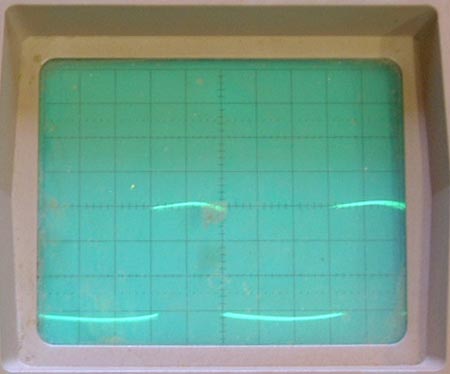 As
that looked ok, on all three phases, I had a look at the output of the alternator when the regulator was connected.
This photos is what two of the phases looked like, which again looks perfectly reasonable.
As
that looked ok, on all three phases, I had a look at the output of the alternator when the regulator was connected.
This photos is what two of the phases looked like, which again looks perfectly reasonable.
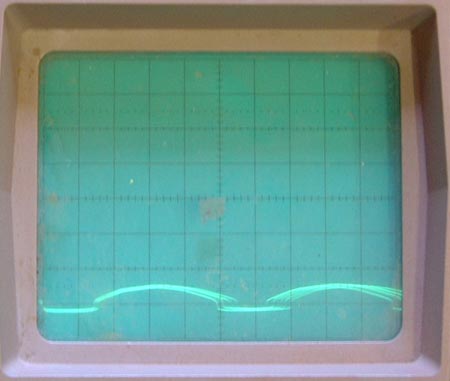 This,
however, is the other phase which does not look right. The obvious reason for this is that the regulator's toast.
The regulator that I've got is actually a heavy duty one as the standard fireblade one is known to be rather weak
and prone to toasting itself.
This,
however, is the other phase which does not look right. The obvious reason for this is that the regulator's toast.
The regulator that I've got is actually a heavy duty one as the standard fireblade one is known to be rather weak
and prone to toasting itself.
However, it looks as though my untoastable regulator is nonetheless having its burnt bits scraped off and replaced with Marmite so I guess I'll have to get a new one.
 As I can't do anything about that, it was back to the cooling. At Snetterton, even though it wasn't
the hottest of days, the water temperature was running at nearly 100° which is definitely too hot.
As I can't do anything about that, it was back to the cooling. At Snetterton, even though it wasn't
the hottest of days, the water temperature was running at nearly 100° which is definitely too hot.
I've come to the conclusion that the only way to really resolve this is to duct the radiator both from the inlet at the front of the car and to an outlet in the top surface of the bonnet. Much like, as I think I've said, the ducted nose on my old Westfield. However, there's clearly no way I can do that before the Birkett so I've decided to try and make sure that all of the air that comes through the front of the car goes through the radiator. The correx extension to the aluminium ducting here fits pretty snugly around the air inlet so we'll see what happens. (Probably be a disaster.)
You will remember that took the oil cooler off for Snetterton. Well, it had the obvious effect really in that the oil ran too hot. However, as the water was too, and the engine's got an oil/water intercooler then I've decided to just ignore the oil temperature. (In fact, I might remove the gauge.) and just concentrate on the water temperature for now.
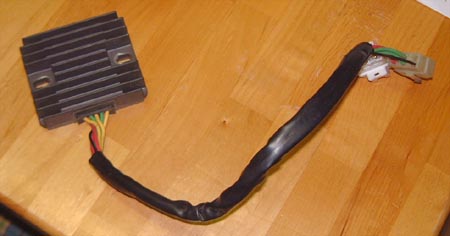 We had a planning meeting for the Birkett the other night. While I was there I picked up a new voltage
regulator from Andy Bates who, as well as being engine supremo, is our team's chief mechanic. This is it sitting
on the kitchen table.
We had a planning meeting for the Birkett the other night. While I was there I picked up a new voltage
regulator from Andy Bates who, as well as being engine supremo, is our team's chief mechanic. This is it sitting
on the kitchen table.
It's a unit from a later injection fireblade and is slight different from the one I've got already. The main difference though is that there's an additional wire going into the regulator comes from the car's switched live. (Actually, on the bike it comes from the engine stop relay.) I'm not sure what this does, it could be a sense input that tells the regulator exactly what the voltage is at the other end of the wires (something that' common on car alternators) or it could be an input into the regulator that shuts the regulator down as soon as the ignition's off.
All the same, I spent a couple of hours this evening wiring it into the car. Of course that's rather harder than you'd think as it'd be nice to just plug those connectors on the right into the car but there's nothing that matches them.
After this was done, I fired up the engine and first indications were that the voltage that I could see at the battery was indeed an improvement on before. However, I'll have a more careful look with the 'scope again when I get a moment.
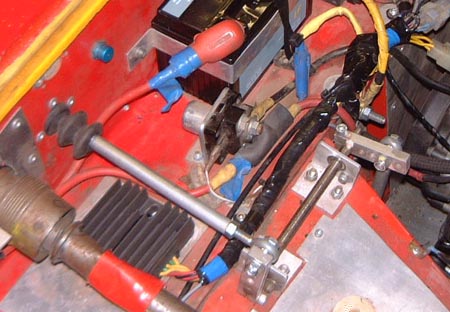 I
didn't have much time to look at the car at the weekend as I was fitting a tow-bar to the new tin-top which is
another Scooby.
I
didn't have much time to look at the car at the weekend as I was fitting a tow-bar to the new tin-top which is
another Scooby.
In between times I replaced the voltage regulator with the new one and it seems to have resolved the problem, although I won't really be able to tell until the car's run in anger.
I also changed the front brake pads as they're just too thin to be confident about them at the Birkett. I actually changed the pad material, mainly as an experiment but also because they're a bit cheaper and as I'm thinking seriously about replacing the brakes over the winter I wouldn't be chucking so much away.
It turned out to be a bloody good job that I'd done this as I noticed that the right hand wheel was scraping slightly on the pads. On closer inspection I found this
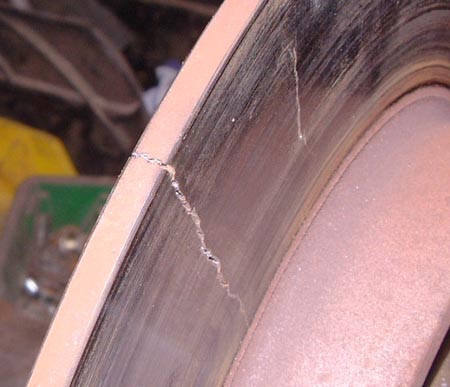 sodding
great crack in the disc. Along with this there's about 2mm of run-out on the disc.
sodding
great crack in the disc. Along with this there's about 2mm of run-out on the disc.
This has put the cat amongst the pigeons as there's no way that I can test or race with this and. of course, I don't have a spare.
However, I've spent a while today talking to people about this. The disc actually came from HiSpec and is sort of a special of theirs. It's machined down, in some way I don't understand, from a standard tin-top disc. (Presumably it's the rear of a fairly light car.) Anyway, to cut a long story short, they're machining another one for me which I should be able to get on Thursday which is just about suitable. Assuming, of course, that it arrives on time.
That still leaves me wondering what to do about the brakes in the long term. I guess in the meantime I'll just wait to see how the Birkett goes and then think about it.
Well, this has all been very frustrating! I got in touch with Martin Bell on Monday and he arranged for HiSpec to machine me a new disc. (Apparently they start out thicker than they lighten them.) I went down today to pick up the disc that was being done first thing this morning. Or, so they said on the phone this morning.
As is typical with HiSpec when I got there it wasn't done. In fact, the office door was even locked; it appears that they don't really want to deal with pesky customers. Still, after an hour's delay I did pick it up and went home. In retrospect I shouldhave looked a little closer as when I tried it it was obvious that it was never going to fit. The old disc had an offset of about 26mm, this one was about 17mm and, as such, it wouldn't fit inside the caliper.
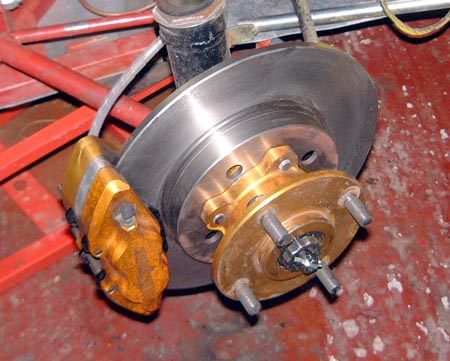 This
is, I have to say, pretty typical of HiSpec and is one of the reasons why I'm determined to rid my car of their
products over the winter. After the various issues with seized nipples and other fragilities (for example, a couple
of competitors have had problems with the inner seals between caliper halves failing in a race) then I don't want
their stuff on my car any longer. It might be better if their approach to customer service was any better but they
are, simply put, a complete bunch of useless idiots at this aspect of their business. If I treated my customers
like this I'd be out of business in a month.
This
is, I have to say, pretty typical of HiSpec and is one of the reasons why I'm determined to rid my car of their
products over the winter. After the various issues with seized nipples and other fragilities (for example, a couple
of competitors have had problems with the inner seals between caliper halves failing in a race) then I don't want
their stuff on my car any longer. It might be better if their approach to customer service was any better but they
are, simply put, a complete bunch of useless idiots at this aspect of their business. If I treated my customers
like this I'd be out of business in a month.
So, after all that I phoned Martin again and he went for a root around and found a disc that was pretty close to what I need. It hasn't been lightened in the same way but that should be OK for this one event at the weekend. What's more, I'm testing on Friday so I should have a chance to properly bed things in.
So, I drove over to Rushden, got that disc and did indeed fit it this evening. There it is in the photo looking all shiny.
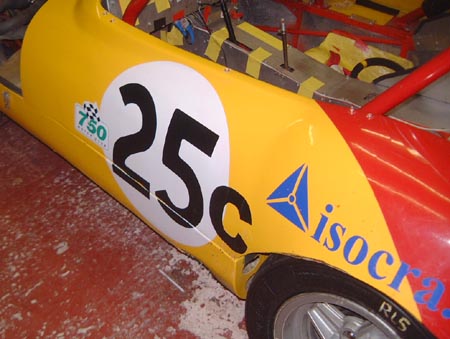 So,
I think the car's just about done. The final thing was actually to change the numbers. We're team 25 for the Birkett
and I'm driver C so that's what it says on the car now.
So,
I think the car's just about done. The final thing was actually to change the numbers. We're team 25 for the Birkett
and I'm driver C so that's what it says on the car now.
For some reason you can't get letters for cars, just numbers. So, as the previous letter (which was coincidentally a C as I'm in class C in RGB) got mangled when taking the numbers off I hate to make some more. So, I printed out a huge letter C and used that as a template to cut up some black gaffa tape. I probably ought to do the same thing with some, as they used to say on the TV, sticky-backed plastic at some point.
So, with luck I can now pack the car and tools up to tomorrow and head off for Silverstone either tomorrow evening or Friday morning.
Wish me luck...
Well, I made it to the Birkett and back. What's more, I had an absolutely fantastic time. It was just about the most enjoyable event that I've done, although bloody tiring. I think what made it so good was actually being in a team of other people.
Anyway, back to the beginning. The weekend started for us with getting up early and heading off for Silverstone on Friday morning. I had booked the day testing on account of the fact that I never felt that I had got the measure of the place, especially after the recent problems there. After setting up camp we set off for the first session. The first job was to bed in the new brake pads and just see if the new disc was actually going to work. So, the first lap out was just 80% of a lap really and the car felt awful. I'd put a run-down set of tyres on it and it was like driving on ice. I seemed to be sliding everywhere. However, after a couple of sessions of that I left things to cool for a while and declared that the pads were bedded in.
After that it was time to start trying to learn the track properly and get the time down. One of my limitations as a race driver is that it takes me a good while to get up to speed with a new track. Or even, as in this case, an old one. However, it would be nice to get the time down to something rather better than before. Before this day my fastest time as 1:09.26 which is just way too slow. So, it was nice that in the first session when I was pushing I managed to get a 1:08.07 which was much better. In the last race at Silverstone, when I made the first corner only, I only got a 1:09.50 so I was already 1.4 seconds quicker than that. In fact, the time from earlier this year got me into 15th in class on the grid. The new time would have made me 11th!
After that I carried on pushing and tweaking tyre pressures and damper setting. Mind you, I ended up with the dampers where I'd started the day! Problem was, though, that I was having trouble getting heat into the tyres as the day was so cold. In retrospect it might have been worth actually letting the tyres down to see if I could make them move around more and so generate some more heat, although I didn't think of it at the time.
After all that, in the penultimate session I got the time down to 1:07.74 which would have been good for 7th in class on the grid which can only count as astonishing. However, up to now I'd been using my duff[er] set of tyres so I was going to put the newer ones on for the last session. Before that, though, I signed on for the race meeting that was the next day and got the car scrutineered. That meant that we wouldn't have to worry about getting it done in the morning.
So. I went out in the last session and pushed a bit harder. In particular, I was trying for force myself to trail brake rather more forcefully into Brooklands so as to try and make the front end stay stuck rather better and it seemed to be working so far. I was also concentrating on staying on the throttle through the Maggotts kink (up to now my fear gland had been kicking in) and that was also having an effect. All the same, I could do with some way of making the car feel more stable through Maggotts as it all feels a bit uncomfortable.
However, I was rewarded with a 1:06.67 which amazed me; I really didn't think I could hope for a time in the 6s. That would have had me in 5th place on the class C grid! What's to bet I don't get anywhere near that again.
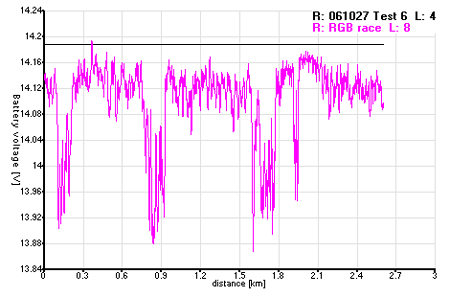 Looking at the
data logs another interesting thing is that the new voltage regulator is having an effect. Before, I've always
been able to tell where I applied the brakes as I could see the effect of the brake lights going on on the battery
voltage. Now it stays absolutely constantand I've got no idea where the brakes are going on.
Looking at the
data logs another interesting thing is that the new voltage regulator is having an effect. Before, I've always
been able to tell where I applied the brakes as I could see the effect of the brake lights going on on the battery
voltage. Now it stays absolutely constantand I've got no idea where the brakes are going on.
You can see the effect on this graph. The black line is the new voltage trace, the purple one is that from a previous race at Silverstone. Those places where the older voltage drops are the braking zones for Copse, Becketts, Brooklands and a little stab for Luffield.
The other thing I'd done before this meeting was to improve the cooling ducting. At first sight this had made a difference to the water temperature, although that observation has to tempered with the fact that it was a cold day. However, the oil temperature was still out of kilter. However, I've been thinking some more about this and one thought is that all of this problem really dates from when I panelled in under the engine. The obvious effect that that has had is to stop the sump getting cooled in the air blast. Normally such sump cooling is an important part of oil cooling and the standard 'blade sump has cooling fins on it. I'm wondering if some sort of attempt to cool the sump directly might get the oil temperatures down to something reasonable without needing the separate oil cooler. There's a few ways I can think of doing this:
- Cutting some holes in the floor panel under the sump.
- Putting something like a small NACA duct in the floor panel in front of the sump
- Arranging for thermal contact between the sump and the floor panel.
Whatever I do, one or more of those has to be worth at least trying.
Anyway, back at Silverstone and the rest of the team arrived in the evening followed by Guy, our team manager. We'd realised late in the day that the Birkett rules really required a separate team manager and we'd appointed Guy to the job. If anything, he was more pumped up that the rest of us.
The following morning we had to all "qualify" which essentially meant we had to do 3 laps of the circuit. I did 4 to be sure, but they were pretty slow. Our grid position was determined by the times that we'd submitted with the entry form for our laptimes around Silverstone. Those times also determined our handicap. The upshot of our handicap was that we were expected to do about 24 laps less than the leaders in the 6 hours, so we could essentially add 24 to our completed lap count at the end. The actual number, though, is subject to tweaking during the race and also some modification for safety car periods of which there were bound to be a few.
The race was to get away at 11am prompt and finish at 5pm. We'd picked Paul Rogers in his R1 Phoenix to be first out and he went off for the usual assembly area/grid/green flag lap/start procedure. After that it was our intention to run roughly 30 minute sessions for each driver (as that was all the fuel that we could carry). The arrangement is that at the end of their session the driver peels off into the pitlane and as the car passes the garage the next team member leaves the garage, crossing behind the car coming into the pits.
I was third out in our team, after Paul and Tony, and I set off wondering what it was going to be like. There was a huge array of machinery out there: Chevron B8s, Caterhams, a team of Pell Genesii from RGB, some 2CVs, some vintage chain-drive Frazer Nashes (one of those was a V8 with exposed valve gear which sounds awesome, a large collection of tin-tops such as BMW M3s, a team of identically liveried Mk I MR2s and so on.
We were expecting huge speed differentials and so it turned out. Before the race I'd thought that the key would be to drive within oneself, not taking any risks. However, as every corner presented a different set of obstacles, mostly slower than us but occasionally quicker, then you really needed your wits about you. At each corner you had to make a decision whether to dive up the inside, try and drive round the outside, exit wide or narrow, and so on. In fact no two laps were even remotely the same. I came in after my first session thinking that I'd probably passed more cars in that 30 minutes than I had in the entire rest of my racing. In fact it had been, in a nutshell, absolutely fantastic.
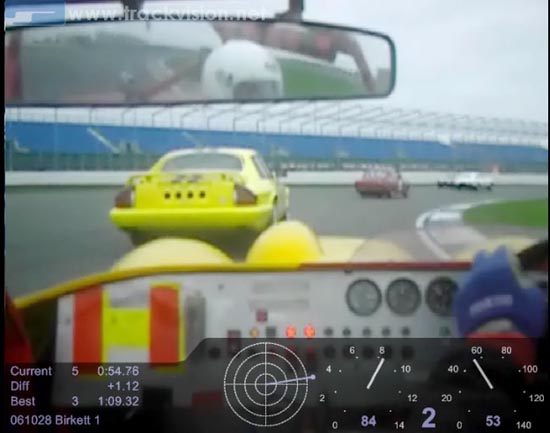 It
seemed to be pretty good from a spectator's point of view too. Every corner was a continual sequence of proper
racing activities. I spoke to a few people in the pits who were genuine spectators. That is, they'd paid money
to get in. All of them said that they were regular attendees at the Birkett and regarded it as a highlight of the
year. I can well understand why.
It
seemed to be pretty good from a spectator's point of view too. Every corner was a continual sequence of proper
racing activities. I spoke to a few people in the pits who were genuine spectators. That is, they'd paid money
to get in. All of them said that they were regular attendees at the Birkett and regarded it as a highlight of the
year. I can well understand why.
The photo here, taken from my in-car video, gives some idea what it was like. This is coming round Luffield and I'm going to go up the right hand side of that Jaguar XJS, round the left hadn side of the Mk II Cortina at Woodcote and up the inside of the Jag E-Type on the exit of Copse. In the case of the last car he and I will be side-by side all the way up to Becketts but the braking performance of an RGB car is so good that I'll leave him comprehensively at Becketts. That was one of the interesting observations from the weekend: these RGB cars are quick. It's hard to believe it from a mere 919cc but my car goes like stink really. I guess that Jag XJS has the 5.3litre V12 engine and he doesn't stand an earthly other than in an absolutely dead straight line.
So, things carried on like that for 6 hours! We actually got quite good at cycling the cars around, hanging out pitboards, timing every lap and so on. As time wore on we settled in 12th place (out of 50) on the track. All the time we were feverishly trying to work out what the effects of the handicap would be but it was pretty hard. In fact, we only knew the on-track position because we'd rigged up a TV in the garage which was connected to the information that they pump out at Silverstone. This includes all the timing information and also CCTV images of all of the circuit.
The race finally finished at 5pm. I only really watched the last 15 minutes of it which Derek was running for us. I must admit that he was spectacular to watch, diving up the inside of people in Copse lap after lap after lap. Eventually it all stopped and Derek coasted in the pits with his car absolutely silent. He'd heard an odd noise coming down the club straight and killed the engine. We stopped and were checking it over when we realised that the issue was that the entire silencer system was missing! It had obvious just come adrift and disconnected itself from the headers. Somehow or other it had also escaped from the sidepod although after a conversation with the marshalls Derek got the vast majority of it back again.
We finished the day with a team photo in front of the garage. Unfortunately, I don't have a copy but when I get one I'll put it here.
Finally, we went off to get the official results. We were indeed 12th on the road and 6th overall on handicap. We were all alarmingly chuffed about that.
So, that's the end of the season's racing. It certainly ended on a high note. Now I need to decide what to do to the car, but I might have a bit of a rest first...